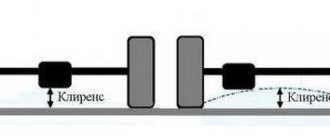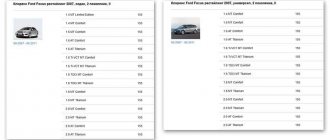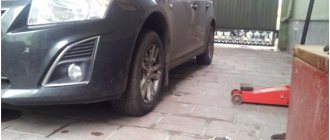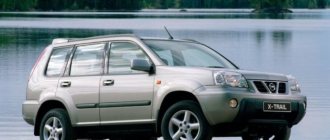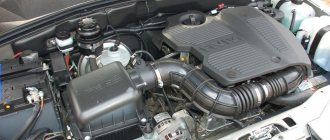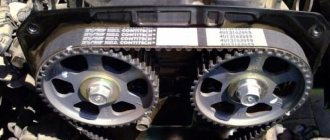Ground clearance is the distance from the lowest point of the body to the support (road). Another name is ground clearance. The closer the bottom of the car is to the road, the higher the stability and controllability of the vehicle. However, on bad roads the bottom may touch uneven surfaces and the body may sag. For this reason, the question of how to increase ground clearance is extremely important for drivers. Here are the 5 best ways to increase ground clearance, which will be useful to owners of modern cars with a ground clearance of 13-18 cm.
New springs
One of the most common methods of increasing ground clearance is installing longer and stiffer springs on the car . This method is effective if the old springs have sagged.
The advantage of the method is that the increase will be significant - from 8 to 12 cm (depending on the type of springs chosen). The effect will be long-lasting. However, the consequences of such actions are difficult to predict.
By adding new springs to the car's design, you can reduce handling. The operation algorithm of the front and rear suspension will change. When turning, the car will begin to roll heavily.
Another problem is the rather high cost of new shock absorbers. Original springs that are ideal for a specific car model are not easy to find, and purchasing parts from a third-party manufacturer is buying a “pig in a poke.”
Ways to increase ground clearance
How to increase car clearance. There are cars with active suspension. Their design includes the ability to change the height of the car literally “on the fly”, raising or lowering depending on driving conditions.
Hydraulic, pneumatic and hydropneumatic systems are controlled by an on-board computer. Provision is made for raising and lowering each wheel depending on the conditions: at different cornering speeds, uneven roads, at the start, braking. Installed sensors assist the movement without driver intervention.
Adjustable Air Suspension (ESS)
Cars equipped with such systems move smoothly, driving is more comfortable and safer. Alas, you have to pay for everything. Both in the literal sense: such models are more expensive, and in the figurative sense - the complication of the design leads to more complicated maintenance and reduced reliability.
A simple way to increase the car's ground clearance is to install different wheels.
It has nuances. Wheels 195/65R15, 205/55R16, 225/45R17, 225/40R18 have almost the same external size. It is necessary to take into account the change in the rubber profile, choose the same profile, but with an increased radius.
There are also failures caused by geometry. With the same number of wheel revolutions, the distance the car travels is different. That is, irregularities in the speedometer readings are possible. The speed sensor is likely to fail in vehicles equipped with ABS and ESP systems, if any. And it won’t be possible to increase it much - the wheel arches will interfere, possibly touching the mudguards.
Another option is to replace the springs and shock absorbers, and supply additional “gaskets”. Many workshops now provide such services. We take into account that the replacement of standard components of the car automatically leads to the loss of the factory warranty, if it has not yet expired. Such replacements also affect the stiffness of the suspension.
It is also worth considering one not very good, often encountered and rarely taken into account minus. Any repair or tuning of a car is fraught with encounters with cross-eyed repairmen. Moreover, outwardly you cannot distinguish them from conscientious workers. Such a meeting easily leads to loss of money, nerves, and time. Theoretically - and life, well, this is in very rare cases.
A car “raised” by tuning, in comparison with the purchased base model, can noticeably lose stability. When entering a corner at speed, the difference is noticeable.
- Video: installing spacers to increase the ground clearance of the Kia Ceed Sportage 3.
- Video: increasing the ground clearance of the Mazda3 due to spacers, shows what happened and how it turned out.
All SUVs are vehicles with high ground clearance. For ease of selection, familiarization and comparison of different models and brands of cars, look at the numbers below.
Tables for comparing clearances
When buying a car, you can decide in advance on the ground clearance. The two tabular forms below will help you with this. See and choose your size.
Car clearance - comparison table. This form shows the difference between cars and SUVs:
Below is a table of the most purchased class B cars; ground clearance increases from bottom to top. Compare the ground clearance of different models and manufacturers, and choose the best option:
The stated ride height does not always correspond to reality. For example, it is clear that a loaded car will “sink” lower than an empty one. According to Russian GOST, measurements are taken in a vehicle loaded to the maximum permitted weight.
And at the Russian representative office of Mitsubishi, when asked by Avtovestya, they answered that the measurements are carried out on a loaded car. That is: there is no driver and passengers, the fuel tank and windshield washer reservoir are filled, there is a spare wheel and a set of tools, a jack. Just a car standing on a stand.
The underbody protection installed in the car “eats” a few more millimeters. Again, the clearance is indicated with the protection removed.
Video: measuring the ground clearance of the Skoda Rapid.
Underbody protection
Additional protection for the bottom of the car is possible. The options are different. There is simply anti-corrosion protection, usually coating with various mastics, paints and the like.
This is not a superfluous thing, since when driving, grains of sand and fine gravel treat the bottom of the car like an abrasive. Using salt on the roads in winter also does not add longevity to the body.
But you can also order more expensive protection that protects the engine crankcase (one of the most expensive repairs), gas tank and other parts from impacts. Theoretically, at least from mine fragments, like on armored personnel carriers. The installation of additional protection itself will slightly reduce the ground clearance, but will save you from significant expenses for repairs.
Video: does the crankcase protect the car?
Larger profile tires and wheels
Installing tires and rims with a larger profile than the manufacturer recommends is a fairly inexpensive method of increasing ground clearance. Among its advantages, in addition to accessibility, the following can be noted:
- clearance increases for a long time;
- the design of the vehicle does not undergo changes;
- ground clearance increases by 1-3 cm.
True, this method cannot be called ideal. The driver is in for an unpleasant surprise in the form of increased fuel consumption. The speedometer will become less accurate, and if friction occurs, new tires will wear out quickly.
Advantages and disadvantages of high ground clearance
Here the benefits are more obvious. Or rather, the most important of them. This is increased cross-country ability. However, do not forget that high ground clearance is not a panacea. Remember that cross-country ability largely depends on other parameters of the machine. It also depends quite heavily on the driver - his skills, experience, caution, skill, instincts and other qualities.
There are many disadvantages, and many do not know about them, or do not pay much attention to them, increasing the clearance in one way or another. Since almost all of them are the opposite of the advantages of low clearance, there is little point in considering them in detail. Therefore, here is a short list:
- deterioration of aerodynamics;
- decreased controllability;
- deterioration of lateral stability;
- deterioration in turning at high speeds;
- increased fuel consumption;
- the tendency of the machine to excessive resonant rocking.
And if the low clearance was eliminated in a makeshift way, not provided for by the manufacturer, then accelerated wear of the CV joint and silent blocks should also be added to the list. By the way, the angle of the wheels (camber) can also change, turning the car into a Tatra truck (for those who haven’t seen it, look it up on the Internet). And if the camber of the front wheels can be adjusted, probably, in any car, then as for the rear wheels, this cannot be done without surgical intervention.
Spacers for shock absorber strut
The essence of this method is to install a spacer in the place where the shock absorber strut connects to the car body. The cost of spacers is low, and the choice is very wide - they are plastic, polyurethane, rubber, metal.
The advantages of the method are as follows:
- availability relative to price;
- the ability to increase clearance by 3−5 cm;
- no changes in the design of the car.
There are also plenty of disadvantages. Due to the installation of the spacer, the car loses directional stability and rolls. The suspension works at a different angle. There is a certain risk of breakdown.
About the consequences of increasing clearance
Having decided to increase the ground clearance, you must understand that the car's behavior on the road will change. The reason lies in raising the center of gravity along with the main mass of the car. What changes will appear:
- in sharp turns the car will begin to roll more;
- at high speed, a deterioration in controllability will become noticeable;
- the braking distance will be lengthened;
- Fuel consumption will increase by 5–10% depending on driving style.
Handling will become worse not only due to the movement of the center of mass. The air flow flowing under the bottom of the car will increase, as a result, the traction force of the tires on the road will decrease. To minimize these effects, it is not recommended to raise the body more than 5 cm from the standard position.
Interturn cushions (buffers)
The buffer is put on medium wide coils of springs. Its function is to support the springs, due to which they do not compress to a critical point. Buffers are inexpensive and can be very different. The simplest products are made of rubber. Polyurethane buffers are considered the most reliable.
Increasing ground clearance using a buffer has the following advantages:
- installation is simple - the driver can do it himself;
- after installation, the load distribution does not change;
- the driving performance of the vehicle is improved;
- ground clearance increases by 2 cm.
- high-quality buffers can last about 100 thousand kilometers.
The only drawback is that it is difficult to find high-quality products on the domestic market. There is a high risk of purchasing counterfeit goods and wasting money.
Advantages of spacers for increasing ground clearance
To be fair, it is worth noting that driving a fully loaded (and often overloaded) car with spacers installed is not accompanied by constant breakdowns of the rear suspension and the rear wheels scraping against the fender liners.
Summary based on the results of personal driving experience for half a year: when installing spacers to increase ground clearance, think first of all about the “health” of the shock absorbers (by the way, we have already written about how to check shock absorbers.), and at the same time about your own safety.
The use of “house” type spacers (special metal fastenings of the lower shock absorber bolts), as a rule, leads to the same results.
Pneumatic cylinder
Installing air suspension is a fairly popular method of increasing ground clearance. However, it is the most expensive. Sometimes the price can be a fifth of the total cost of the entire car.
Now there is an alternative to air suspension - an air spring. It is inserted into the rear springs and then inflated with air. The method has the following advantages:
- increased ground clearance (by an average of 5 cm) and the possibility of its adjustment;
- increasing the vehicle's load capacity and handling.
The only disadvantage of this method is the need to manually inflate the air cylinder. If you exceed the permissible limit when inflating, the balloon may simply burst. However, if you act carefully, the product can function properly for many years, effectively increasing the vehicle's ground clearance.
How to increase ground clearance (clearance)
Increasing ground clearance is most often done by off-road driving enthusiasts, hunters and other people who like to go out of town. Roads in the city are significantly different from country roads. That is why increasing the clearance for cars unsuitable for these roads is one of the most important procedures.
- First method. An increase in ground clearance is achieved by installing wheels with a larger diameter. This is especially true for cars with basic equipment.
Among the disadvantages of this method are the appearance of a speedometer error and the limitation of the diameter by the wheel arches. This means that if you install a wheel that is too large in diameter, it will hit the arches on sharp turns.
- Second method . Installing spacers under the fastenings of suspension parts to the body, for example, springs, also allows you to increase ground clearance. Complete with spacers, you should purchase shock absorber extensions, or new extended shock absorbers, since when entering a deep hole, the shock absorber may fly out of the cup.
The disadvantage of this method is that the rear spacers are much thicker than the front ones and the increase in ground clearance occurs unevenly. In this regard, the brake force regulator, or “sorcerer” as it is called, receives incorrect information. However, the “sorcerer” has the ability to regulate.
- Third method. It is reminiscent of the second method and consists of replacing standard springs with springs with a large number of turns. In this way, a significant increase in ground clearance can be achieved. However, as in the second method, it is necessary to lengthen or replace the shock absorbers for the same reasons.
Compared to spacers, new springs will last much longer and more reliably, however, in addition to the same disadvantages, they have a high cost.
- Fourth method. Reinforced springs. This option is used for vehicles that are operated at full load. They can be pickup trucks and station wagons, which have the ability to transport large cargo. Reinforced springs do not increase the vehicle's ground clearance, but their use eliminates "sagging" under full load, while maintaining normal ground clearance and protects the underbody from damage due to uneven road surfaces.
Among the advantages of this system, one can note an increase in the service life of the entire chassis, however, the comfort of a trip without a load is reduced, since the rear part will “spring” on small bumps.
